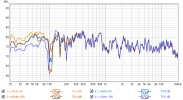Well, this has not been my experience at all. Really the opposite. 100%.
If I might ask, why on Earth would it be true? Do you really have subs that can't play 200hrz @ 24db down from baseline cleanly?
I suppose some truly bad sub could have some crazy peaking there by where they are actually not down enough acoustically.
At any rate OP
@Acerun keep your driver acoustic centers about 1/4 wavelength away or closer at the acoustic crossover frequency. (electrical means ziltch) measure the acoustic falloff.
So @80hrz the wave is about 168" so keep drivers within about 4 feet
So @ 100hrz the wave is 135" so keep the drivers within about 3feet
@ 150hrz the wave is about 90" so keep within about 2feet.
You can fudge this a little and expand the distance as there is so much bass bouncing off boundaries so soon a typical room that it is not even close to an exact science at these large wavelengths.
Plus in stereo you already have 2 or more woofers much further apart than the above yet often playing the same frequency at the same time in each L and R channel(but not mixed in stereo).
Also
@Acerun remember electrical slopes are not what matters at all, acoustical slopes and acoustical summing is the key so measure and experiment with slightly different values for high and low pass. You can also try 48db slopes on the sub if you cross really high.
I often use 48 for the lowpass and 24 for the high pass when I go really high , like 150-200hrz.
Also I suggest the moving mic method averaged over a period of say 30seconds to a minute for this kind of measurement. Not single sweeps.
Also in the bass for adjustments below say 150hrz ish, use 1/12 or 1/24 octave with high Q filters. Above that 1/6 or even 1/3 is totally fine.
After granular adjustment look at the pyscoacoustic or 1/2 smoothing and see if you lost to much bass tone, if you did shelf the bass up a bit(or down if it high)

